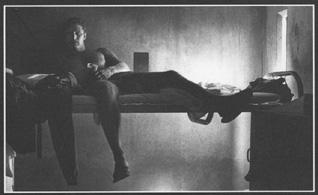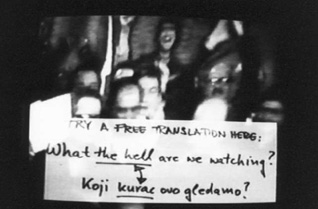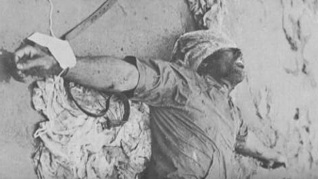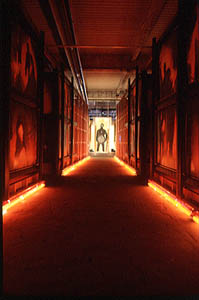STATEMENTS
Photographs
Photographs from the book The Prison Experience (1988) by Morrie Camhi; gelatin-silver prints by Camhi with accompanying inmate statements, California Medical Facility, Vacaville, California (despite the name, a very small percentage incarcerated there are in for medical reasons). The book, on display on the shelf, gives voice to, and provides representation of, inmates, staff, and their spouses; it records the thoughts of victims as well as prisoners and provides pertinent statistics on prisons. Camhi spent two years getting to know the inmates, evolving a conversational intimacy that resulted a body of work that he refers to as "considered photographs." The statements have not been edited down from a larger text or oral history, but were written by inmates in response to the question posed by the artist: "What do you want people to know about the prison experience?"

"Richard
Lee Dodgin, Prisoner, CMF, Vacaville" from
The
Prison Experience (1988) by Morrie Camhi
Cook Country Jail and Joliet/Stateville Prisons (1990-95) Lloyd DeGrane; gelatin-silver prints; the photographer reveals the over-crowding, the horrific segregation facilities, and the frustration and anger of the inmates. Carefully negotiating between the restrictions placed on him by the warden and the expectations and suspicion of the inmates, DeGrane brings back a disturbing view of life in Illinois's correctional facilities.
Omega Suites (1991-92) by Lucinda Devlin; Ektacolor Type - C prints; the artist protests the inhuman practice of capital punishment by revealing what is largely hidden from the public's view, the sterile-looking execution chambers located at various penitentiaries across the United States. The images both attract us (due to design and color) and yet repel us (due to the subject matter).
"Cell Block Table," from the book Conversations with the Dead (1971) by Danny Lyon; gelatin-silver print from the book that was instrumental in getting the release of an abused Texas Prison System inmate, Billy George McCune, who had spent many years in a small segregation cell. (Loaned by Lewis Koch, Madison, WI).
La Pinta: Doing Time in Santa Fe (1982 - 1983) by Robert Saltzman; a series of type-C color and silver gelatin prints by Saltzman, in collaboration with inmates so pictured. Inmates of the New Mexico State Penitentiary have a special word in Spanish slang for the location of their incarceration—"La Pinta." Meaning spot or mark, it identifies with a stigma. Ironically, for the Mexican American inmates, it can also mean "to play hooky."
Saltzman came to know La Pinta while visiting friend and fellow artist Jim Wagner during the latter's nine-month imprisonment. Saltzman was moved by what he observed in the faces and relat- ionships of those who serve time, and work, behind bars. In response to his first encounter with the inside, Saltzman approached the warden with a proposal to photograph the prisoners and prison life from the viewpoint of an artist rather than a photojournalist. He was granted permission with some reservation since this prison in 1980 was the site of one of the worst inmate-uprisings in American penal history. Over the course of fifteen months between 1982 - 1983, Saltzman became well-acquainted with prison officials, staff, and the inmate population, producing a body of some 500 images. Although his photographs captured imprisonment on one level, Saltzman felt the energy and sentient individuality of confinement was lost. Mounting a selection of works on illustration board, he returned to his subjects, asking them to add personal statements to the remaining wide border in whatever way they wished. The images in this exhibition (only 14 out of 28 total works) present the results of this collaboration between the artist and his inmate subjects. The drawings and writings, coupled with Saltzman's portraits, communicate a poignant and often tension-filled commentary on the prison experience.
Videotapes
Nomads at the 25-Door (color, 45 minutes, 1991) by Jeanne C. Finley; a "radical video text" exploring the topic of women in prison; it subverts the traditional documentary, talking-heads, format and the authorial dominance over the passive carceral subject. The tape shifts elliptically from an interview with a young woman serving two life sentences for murder in a facility in Nevada to the interviewee becoming an interviewer, asking about Finley's video projects in Yugoslavia and Bulgaria during the fall of Communist domination; finally, the tape returns to the original scene as, in turn, the interviewed inmate interviews her fellow female inmates.

Still
from the videotape Nomads at the
25-Door
(1991) by Jeanne C. Finley
Attica (black-and-white film preserved on video tape, 80 minutes, 1971) by Cinda Firestone; a film documentary on the Attica Prison Uprising for basic rights and better living conditions at the New York State Prison. Television films less sympathetic to the inmates point-of-view have recently aired, such as the HBO production "Against the Wall."

Inmate
killed by the Attica assault force,
Sept.
13, 1971 (New York State Police Photo)
Correcting Corrections, Part I: Crimes of Punishment (color, 30 minutes, 1993) and The CIA of Government (color, 30 minutes, 1993) produced by Marshall Weber, Glen and Jackie Austin. A Safety Orange Video Wedge by WI CURE, Inc. The tapes reveal in-prison abuses, questioning the supposedly "progressive" nature of the Wisconsin State Prison System.
Dawn Dedeaux's videotape is unavaible for screening; it was confiscated by the F.B.I. (see the news article) . The tape we had hoped to show is a collaborative work with New Orleans gang-members inside and outside prison; it and all of Dedeaux's video material was taken by the F.B.I. as evidence in a capital murder case against two subjects in her tapes, Paul and Wayne Hardy, New Orleans gang-members. Although the judge excluded the tape from the trial, none of her tapes have been returned as of the opening of this exhibition. Wayne Hardy was killed in a drive-by-shooting in 1995, while his brother Paul has been convicted of murder and given the death-penalty. Dedeaux has also done large installation works featuring photoworks depicting the Hardy Boys (see below).

Soul
Shadows: Urban Warrior Myths
(installation,
1993) Dawn Dedeaux